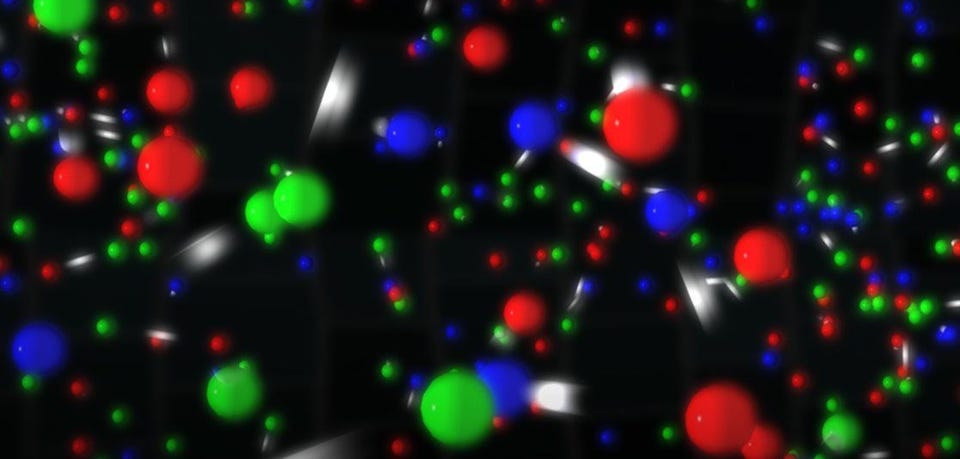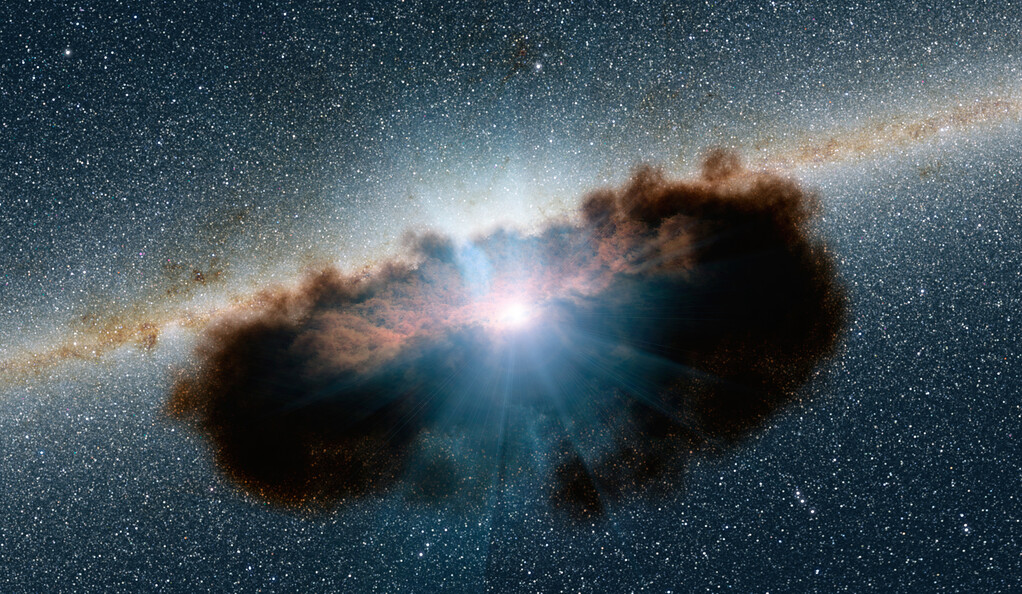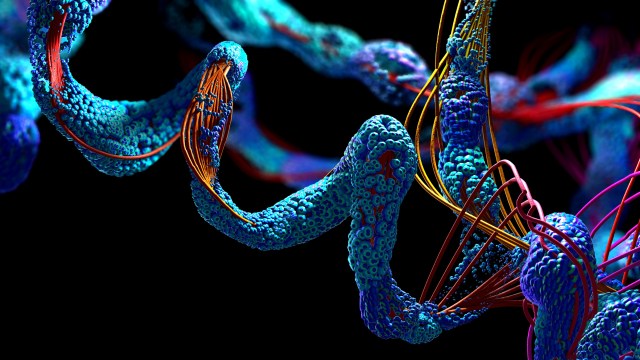The Milky Way’s next supernova could reveal dark matter

- On average, modern spiral galaxies like our Milky Way experience somewhere around one supernova per century, but we haven't seen one directly since 1604.
- The next time one goes off, however, we'll have something working for us that we haven't had in all the supernovae to come before: an array of powerful, sensitive neutrino detectors.
- Neutrinos are supposed to carry away some ~99% of a supernova's energy, but if there's an unexpected deficit, dark matter's presence and interplay will be to blame.
In all the Universe, there are few mysteries that loom as large as dark matter. We know, from the gravitational effects we observe — at all times and on scales of an individual galaxy and upward — that the normal matter in our Universe, along with the laws of gravity that we know, can’t account for what exists. And yet, all of the evidence from dark matter comes indirectly: from astrophysical measurements that don’t add up without that one key missing ingredient. Although that one addition of dark matter solves a wide variety of problems and puzzles, all of our direct detection efforts have come up empty.
There’s a reason for that: all of the direct detection methods we’ve tried rely on the specific assumption that dark matter particles couple to and interact with some type of normal matter in some way. This isn’t a bad assumption; it’s the type of interaction we can constrain and test at this moment in time. Still, there are plenty of physical circumstances that occur out there in the Universe that we simply can’t recreate in the lab just yet, and if dark matter interacts with normal matter under those conditions, it will be the laboratory of the Universe — not an experiment on Earth — that reveals dark matter’s particle nature to us. Here’s why the Milky Way’s next supernova might just be the perfect candidate for doing so.

Although there are numerous types of supernovae that can occur within the Universe, the overwhelming majority that we see are of one particular variety: a core-collapse (or type II) supernova. Whenever stars are born in large numbers, they follow a specific mass distribution, where less massive stars are formed in great numbers but more massive stars, although few in number, represent a significant portion of the total mass of the newly formed stars. The most massive of the stars that form, more than about 8-10 times the mass of the Sun, are destined to die in a core-collapse supernova in only a few million years.
Even though the supernova signals we’re used to seeing occur across the electromagnetic spectrum — in various wavelengths of light — the overwhelming majority of a core-collapse supernova’s energy gets carried away not in the form of light, but rather in the form of neutrinos: a class of particles that only interacts very weakly with all other forms of matter, but which plays an immense role in nuclear processes. In a core-collapse supernova, some ~99% of all the energy released is released in the form of neutrinos, which easily escape the star’s interior and carry energy away very efficiently. It’s this process that typically leads to the core’s implosion and the formation of either a neutron star or a black hole as a result of a core-collapse supernova.

In particle physics experiments that we perform in the lab, neutrinos are only very, very rarely detected. Neutrinos have three properties that explain why this is so.
- Neutrinos only interact through the weak nuclear force, which is a highly suppressed interaction under normal conditions relative to either the forces that hold atomic nuclei together (the strong nuclear force) or the forces that govern charged particles, electric currents, and light (the electromagnetic force).
- Neutrinos have a very small cross-section with normal matter: things like atoms, protons, etc. For a typical neutrino produced in a Sun-like star, for example, it would take about a light-year’s worth of lead as a detector to have about a 50/50 shot of having your neutrino interact with them.
- And the neutrino cross-section scales with neutrino energy; the more energetic your neutrino is, the more likely it is to interact with matter. Neutrinos made from ultra-high-energy cosmic rays are far more likely to interact with matter than a supernova-created neutrino, a solar neutrino, or (most difficult of all) a neutrino left over from the Big Bang.
If something only produces a small number of neutrinos, you have to be both very nearby and must wait a long time before you can be confident you’ve robustly detected the neutrino signal you’re searching for.

But if something produces an enormous number of high-energy neutrinos, and produces them either all at once or over an extremely short period of time, the detectors that are operating all across the globe will have no way of avoiding the neutrino signature that’s permeating the entire planet. We know that galaxies like the Milky Way produce supernovae roughly once per century, with some actively star-forming galaxies producing more than one per decade while other, less active galaxies produce them only a few times per millennium. As a large but quiet galaxy, we’re on the slower side, but far from the slowest.
Although the last naked eye supernovae within the Milky Way occurred in 1604 and 1572, there have been two others that have occurred in our own galaxy since that time:
- Cassiopeia A, which occurred in 1667 but was obscured by light-blocking galactic dust in that direction,
- and G1.9+0.3, which occurred in 1898 but was near the galactic center, and thus was not visible within the plane of the Milky Way.
We didn’t have any neutrino detectors online back in 1898, but there were a number of apparatuses that were sensitive to neutrinos operating in 1987: when a supernova from just outside the Milky Way — in the satellite galaxy of the Large Magellanic Cloud — spontaneously detonated.

Technically, the star that underwent core collapse and became a supernova didn’t do so in 1987; it did so some ~165,000 years ago, with its light only arriving from so far away in 1987. But just a few hours before the light signal arrived, something wonderful and unprecedented occurred: a stream of high-energy neutrinos, all localized to the Large Magellanic Cloud, struck three of our neutrino detectors here on Earth. Although only a total of just over 20 neutrinos arrived over a timespan of about 12 seconds, this event marked the birth of neutrino astronomy beyond simply the Sun, nuclear reactors, and those created by cosmic rays striking Earth’s atmosphere.
What’s vital to understand about this supernova is that:
- It detonated a whopping 165,000 light-years away, well outside our Milky Way. Because the neutrinos generated in its core spread out like a sphere, we would have detected 100 times as many neutrinos if it were only 10% as distant, or 10,000 times as many if it were just 1% as distant. Betelgeuse, a supernova candidate, is only 650 light-years away; some 64,000 times as many neutrinos would arrive from it as did from SN 1987a.
- And that, in 1987, our neutrino detectors were primitive, small, and few in number. Today, we have many thousands of times the detection sensitivities that we did a scant ~35 years ago.

In 1987, the world’s most sensitive neutrino detector wasn’t even designed to detect neutrinos; it was designed to search for decaying protons. By building an enormous, shielded tank of water — rich in protons — and lining that tank with detectors that could be sensitive to even a single photon, any decay that resulted in a charged particle moving faster-than-light in the medium of water would be able to be successfully reconstructed.
While protons don’t decay, neutrinos from all sorts of cosmic sources strike the atomic nuclei in the molecules present within the tank. An energetic-enough neutrino can either produce an atomic recoil or can kick out a charged particle, both of which can make a detectable signal. Located in Kamioka, Japan, the 1987 experiment was called Kamiokande: the Kamioka Nucleon Decay Experiment. After that 1987 event, the experiment was swiftly renamed to Kamiokande: the Kamioka Neutrino Detector Experiment.
Since that time, Kamiokande has been upgraded numerous times: to Super Kamiokande, Super-K, and now Hyper-K. Other neutrino detectors have come online, such as JUNO, IceCube, and the under-construction DUNE among them, the latter of which just might surpass them all in terms of sensitivity.

Today, if a core-collapse supernova went off within the Milky Way, it would be a safe bet that millions — and perhaps even tens or hundreds of millions — of neutrinos should be detectable from Earth. The physics that we expect to occur within core-collapse supernovae is understood, and hence, we can predict how many neutrinos should be produced and what their energy spectrum should be. Even though neutrinos oscillate, changing from one species to another as they interact with matter along their journey from being generated in the heart of a dying star until they arrive at our detectors, we can precisely predict how many should be detected from each species (electron, mu, and tau) based on measurable, observable parameters.
In other words, there’s an explicit prediction for how many supernova-based neutrinos we’d expect to detect, flavor-by-flavor, and what their energy spectrum ought to be. That is, we know, based on the physics we know, how many neutrinos to expect from a core-collapse supernova no matter where it occurs, and that simply by observing the electromagnetic radiation and how it behaves as a function of time, we can infer what those neutrino observations ought to have been.
And that’s where the exciting part comes in: the observations and our predictions might not line up.

Back in the 1960s, when we first started measuring neutrinos from the Sun and began comparing them with our predictions, we noticed a problem: there was a deficit from what was expected. We were only observing about a third of the neutrinos that we predicted we ought to see, creating a longstanding puzzle. Eventually, we realized that even though the Sun was producing 100% electron neutrinos, by the time those neutrinos interacted with our detectors, they had oscillated into the other two species (or flavors) of neutrino: muon and tau neutrinos. Only once neutrino oscillation was understood — which required becoming sensitive to detecting at least one of the other species — was the puzzle resolved.
But now, armed with an understanding of both neutrino production and neutrino oscillation, we should truly be able to predict how many neutrinos should arrive from a core-collapse supernova occurring within the Milky Way. However, this assumes that our Standard Model-based predictions for how core-collapse supernovae proceed, which only includes the particle physics that we know of, is representative of all the physics that actually exists. And there exists the possibility, because it’s a prediction that’s never been tested, that perhaps dark matter is carrying some of the energy away that we had suspected would be carried by neutrinos.

The nuclear reactions at the heart of a core-collapse supernova are going to occur at pressures, temperatures, and densities that have never been produced in a laboratory here on Earth. Even though we have theoretical predictions for the particle physics interactions that we expect to occur, measurements from heavy ion colliders — such as RHIC and the LHC — can only tell us what occurs in the regime where data exists. Even though we have expectations that no novel physics beyond what’s already known and established should play a role in the hearts of core-collapse supernovae, the only way to know for sure is to make the key observations and measurements.
In particle physics, we’ve long searched for ways that dark matter might carry energy away from certain types of reactions, like an additional “invisible” decay channel. That’s been sought in the lab for a very long time, but no one has seriously applied that same line of thought to the messy astrophysical environments that lead, in their final moments, to either a neutron star or even a black hole. Under these extreme conditions, it only makes sense to look for a substantial neutrino deficit. After all, 99% of the energy in a core-collapse supernova is expected to be carried away in the neutrino signal. If even a small percentage is carried away by dark matter instead, an observed neutrino deficit could not only point to dark matter, but it could point the way toward the types of experiments that might finally directly detect it.

All of this assumes, of course, that the Milky Way’s next supernova occurs when our neutrino observatories are active and taking data, and that the next supernova is indeed of the core-collapse (type II) variety. While across the Universe, core-collapse supernovae are far more common than the other types, the ones that have occurred in recent history in our own galaxy suggest that we might be experiencing more type Ia supernovae as a fraction of the total than the rest of the Universe. If our next supernova is indeed a type Ia, it must be located within a few thousand light-years for us to be able to perform the necessary tests.
Chances are that when we do detect the neutrinos from a core-collapse supernova occurring within our Milky Way, we won’t find any new physics, and it will behave exactly as the boring old Standard Model predicts. But when you’re searching for any signals of what might lie beyond our current picture of reality, you have to look at details you’ve never looked at before. No matter how it turns out, we can be sure that our galaxy’s next supernova will provide a cosmic deluge of information. Just make sure, when that key data arrives, that we keep our minds open even to the wildest of possibilities. The data just might lead us to a revolution that very few of us are expecting!





